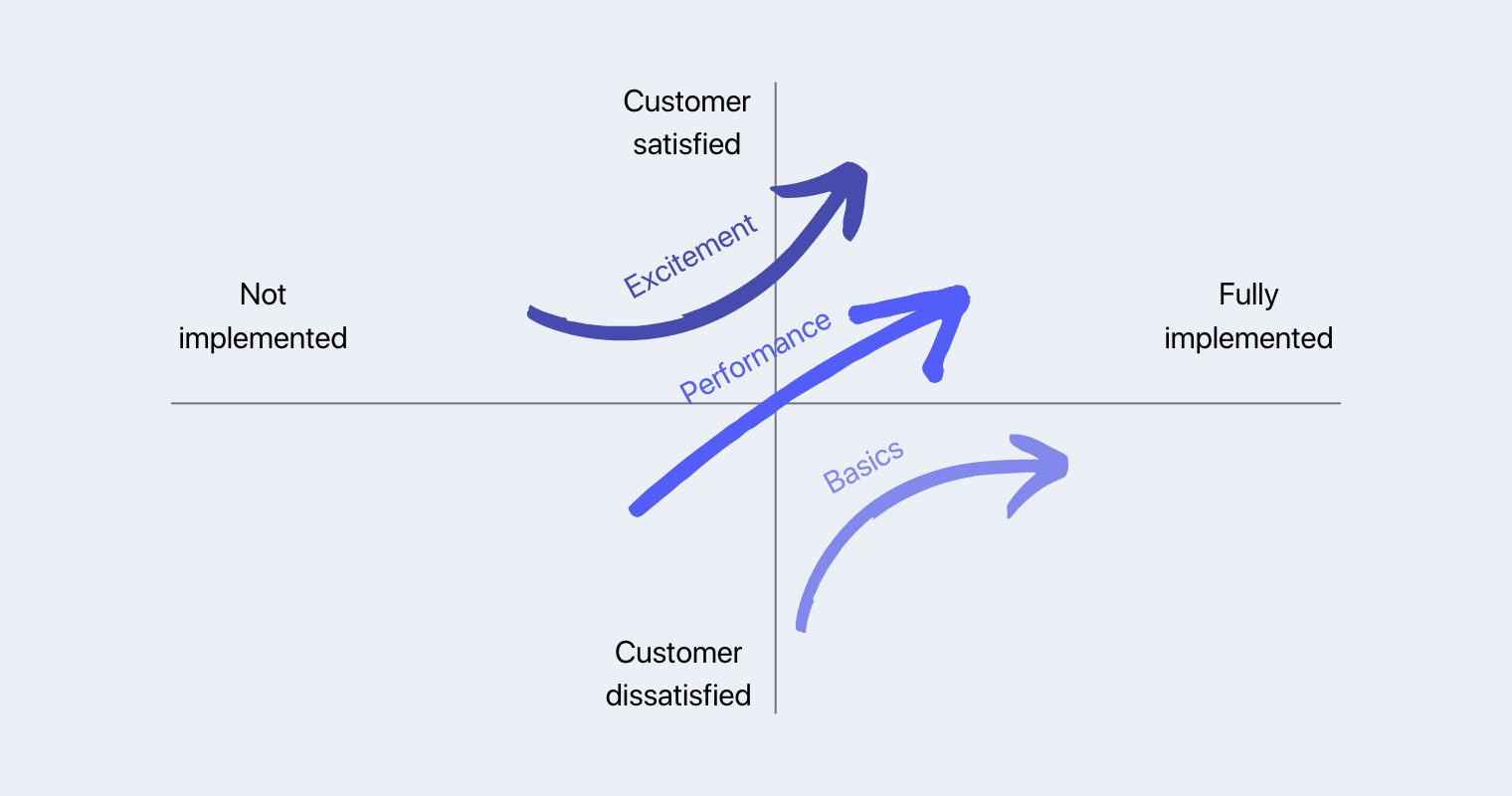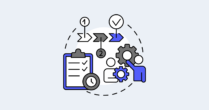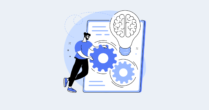The Kano model is a tool every product manager should know.
Imagine you’re cooking a special meal. You need to know which ingredients are essential and which ones will give that extra zing. That’s what the Kano model does for product features.
Why is it important? It’s about making smart, impactful choices. This model helps you figure out which features will satisfy your customers, which will delight them, and which might let them down. It’s a practical approach to understanding customer needs and exceeding their expectations.
Ready to explore how the Kano model can change the game for you in product management? Let’s get started!
What is the Kano model?
The Kano model is a prioritization framework that product managers use to plan the roadmap. It helps product development and customer satisfaction as well. To use the Kano model, you need to categorize customer preferences into different levels. This helps to determine how various aspects of a product can influence customer satisfaction.
History of the Kano model
Dr. Noriaki Kano, a Japanese professor, created the Kano model in 1984. His goal was simple yet powerful: understand what makes customers happy.
Dr. Kano’s idea was groundbreaking. He saw that not all features in a product are equal in customers’ eyes. Some are must-haves, while others are nice surprises. His model aimed to identify these different factors.
The core of the Kano model is customer satisfaction. It’s all about figuring out what customers expect, what they love, and what they can do without. Since 1984, this model has been a key tool in product management. It helps teams make products that people not only use but also enjoy.
Dr. Kano’s insights from decades ago still guide product managers today.
Understanding the Kano model
The Kano model breaks down features into categories based on how they affect customer satisfaction.
Kano model categories
First, there are ‘Basic’ features. Think of these as the essentials. If these are missing or done poorly, customers are unhappy. They’re like the foundation of a house – without them, everything else falls apart.
Next, we have ‘Performance’ features. These are directly linked to customer satisfaction. The better these features are, the happier your customers will be. It’s a straightforward deal: improve these features and improve satisfaction.
Then, there are the ‘Excitement’ features. Sometimes people call these “Delighters.’ These are the surprise elements. Customers don’t expect them, but they love them when they’re there. These features can turn a good product into an amazing one.
The critical role of the Kano Model in feature prioritization is balancing these categories. It’s not just about adding more features. It’s about understanding which features will bring the most satisfaction to your customers.
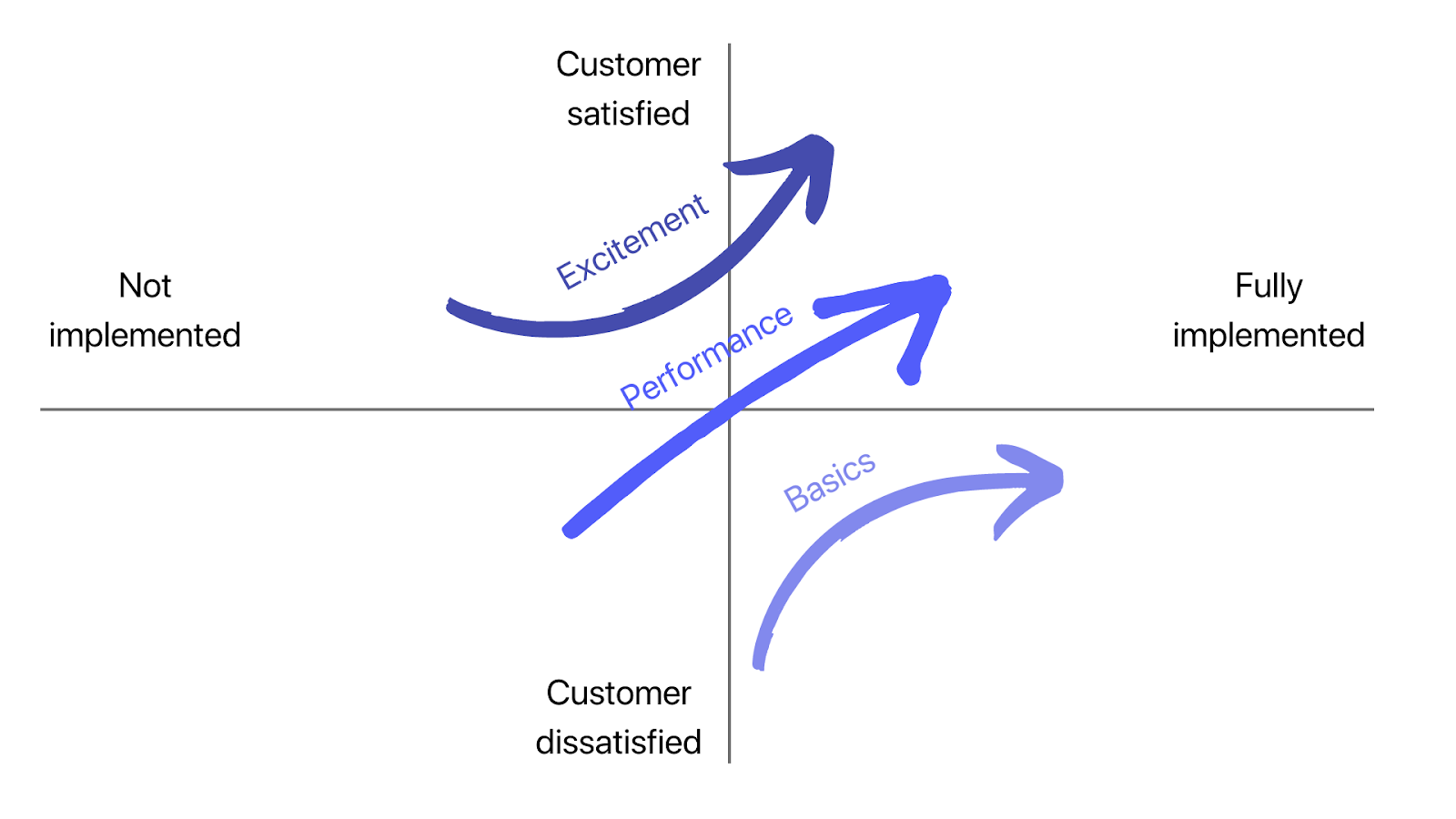
‘Indifferent’ features are those that customers don’t particularly care about. Their presence or absence doesn’t significantly affect satisfaction. They’re like the color of a basement – not a deal-breaker for most.
Lastly, there are ‘Reverse’ features. These are unique in that customers might actually be dissatisfied if they are present. It’s like adding too much spice to a dish – it can be a turn-off for some.
Let’s walk through an example. Imagine you’re creating an app.
| Kano model category | Basics | Performance | Excitement | Indifferent | Reverse |
| Explanation | Non-negotiables | Satisfaction growers | Cherries on top | Neutral impact | Potential turn-offs |
| Example | Sending and receiving emails | Spam filtering | AI-powered replies | Customizable font styles | Intrusive pop-up ads |
Using the Kano model, you’d ensure the app nails sending and receiving emails first. Next, you’d work on a robust spam filter. Finally, you’d add AI-powered replies to really stand out.
The evolution of features in the Kano model
In the Kano model, features evolve over time. What starts as an excitement feature can become a basic necessity. It’s all about how customer expectations change.
From excitement to basic
Initially, a feature might wow customers because it’s new and unexpected. Over time, as it becomes more common, customers expect it as standard. It moves from an ‘Excitement’ feature to a ‘Basic’ feature.
Example: mobile phone battery life
When mobile phones first came out, a long-lasting battery was a delight. Users were thrilled with batteries that lasted more than a few hours. This used to be an ‘Excitement’ feature.
Now, a long battery life is a must. It’s no longer a delight; it’s expected (‘Basic’ feature). If a phone doesn’t last a full day, it’s seen as a drawback.
This evolution reflects how technology and user expectations change. What was once a luxury becomes a standard. Understanding this shift is crucial for product managers. It helps in planning future feature enhancements and staying ahead in the market.
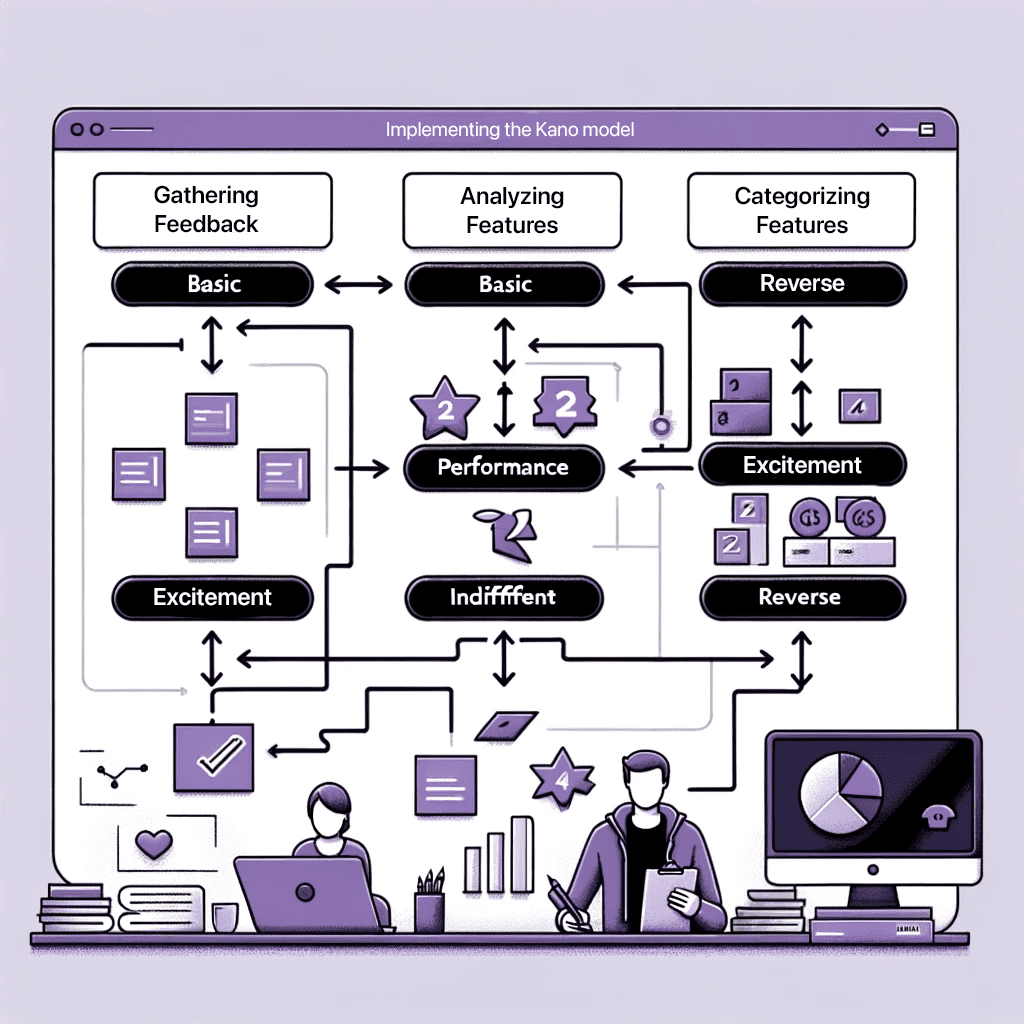
Implementing the Kano model
Using the Kano model effectively means getting into your customers’ heads. Here’s how you can do it.
Customer surveys and feedback for categorization
Surveys are your best tool. They let you hear directly from your customers. This feedback is gold for categorizing features into Basic, Performance, and Excitement.
- Craft effective surveys
Keep it simple. Ask straightforward, direct questions. Make sure each question targets a specific feature. Your goal is to understand how much each feature matters to your customers.
- Ask the right questions
Use functional (positive) and dysfunctional (negative) questions. For example, ask: “How would you feel if this feature were available?” and “How would you feel if this feature were not available?” This approach helps you gauge the impact of each feature.
- Analyze responses
Look for patterns. Which features are consistently seen as must-haves? Which ones bring excitement? Responses will show you which features are vital, which are nice-to-haves, and which might not be necessary.
Ricardo Vargas highlights how the Kano model can effectively prioritize product features based on their potential to satisfy clients. Check out his podcast to hear more from him.
Continuous customer feedback
In product management, staying in tune with your customers is critical. Here’s how continuous feedback plays a crucial role.
Adaptive feature categorization
Customer needs evolve. What’s exciting today might be basic tomorrow. Regular feedback helps you re-categorize features as customer preferences change.
Ongoing engagement
Keep the conversation going. Regular check-ins with users keep your product aligned with their needs. It’s like having a constant pulse on what your customers really want.
Data-driven decisions
Let feedback guide you. Analyze the data to understand trends and patterns. This approach ensures your decisions are backed by solid customer insights, not just gut feelings.
Embracing continuous feedback helps you stay agile. You’ll be better equipped to adapt features, engage with your customers, and make decisions that hit the mark.
Canny’s feedback management software offers a complete tool for feedback and product management. You can prioritize features, keep the conversation going, and analyze trends all within Canny. Give it a try today!
Integrating feedback into product roadmaps
Feedback isn’t just valuable; it’s essential for shaping your product’s future. Here’s how to weave it into your product roadmap.
Align with strategic goals
Match feedback with your long-term vision. Ensure that customer insights support the broader objectives of your product. It’s about finding that sweet spot where customer needs and business goals meet.
Prioritize features
Use feedback to rank features. Look at what your customers say and weigh it against your product’s capabilities. Focus on features that align with customer desires and your strategic goals.
Kano model insights guiding UX design
The Kano model offers valuable insights for enhancing UX/UI design.
Feedback on ‘Excitement’ features can inspire creative UX/UI enhancements. They’re about adding elements that users don’t expect, but love once experienced.
Improve user interface aspects that directly impact user satisfaction. This might include streamlining processes or enhancing the interface’s efficiency.
These insights ensure that every design element meets user needs and contributes to an engaging and satisfying user experience.
Real-world examples
That’s all great in theory. But how does it actually work? Here are some examples of well-known companies using and implementing the Kano model.
Apple
Known for its innovative products, Apple often includes delighters in its product launches. For example, the introduction of the touch screen on the iPhone was a delighter that exceeded customer expectations.
Amazon
Amazon’s introduction of free two-day delivery for Prime members started as a delighter and became a must-have feature for online shoppers.
Netflix
Netflix introduced personalized recommendations based on viewing history, creating a delighter for its customers. This feature not only exceeded customer expectations but also increased customer loyalty and retention. Additionally, Netflix’s introduction of original content, such as the hit series “Stranger Things,” was a performance attribute that satisfied customer needs and expectations.
Challenges and best practices in implementing the Kano model
Implementing the Kano method has its challenges. Here’s how to navigate them effectively.
Addressing biases
Be aware of biases in customer feedback. Diverse sources of feedback can help balance these biases. Considering a wide range of user perspectives is crucial to get a true sense of needs and desires.
Resource allocation
Balance is key. Invest in basic features for stability, performance features for satisfaction, and excitement features for delight. Prioritize based on customer impact versus resource investment.
By being mindful of these aspects, you can effectively utilize the Kano method to enhance your product development strategy.
Kano model versus other frameworks
There’s no one perfect framework. We’re breaking down the Kano method in this article. But other methodologies are worth mentioning too. Let’s see how the Kano model compares to other popular approaches.
| Framework | Focus | Approach | Application in product management |
| Kano model | Customer satisfaction | Categorizing features based on customer satisfaction levels | Prioritizing features for development |
| MoSCoW | Prioritization | Must have, Should have, Could have, Won’t have | Determining what features to build first |
| Value Proposition Canvas | Customer needs and value creation | Aligning products to customer pains and gains | Designing products that meet market needs |
| Jobs-to-be-Done | Customer needs | Focusing on the ‘job’ a product does for customers | Understanding and meeting customer requirements |
| Planning Poker | Estimating effort | Agile teams estimate the effort of tasks | Planning and allocating resources for development |
| Lean startup methodology | Rapid prototyping and testing | Build, Measure, Learn cycle | Iterative product development |
| Feature-driven development (FDD) | Feature scope and delivery | Planning and tracking development of features | Incremental and iterative software development |
| Quality function deployment (QFD) | Customer requirements | Translating customer requirements into product specs | Ensuring products meet customer expectations |
Most product managers use a combination of a few frameworks. Sometimes, they’d use one methodology for one feature and a different approach for another feature. Other times, they distinguish approaches based on the teams they’re working with.
Sometimes, a larger company has a few products, so a product manager can select the best framework for each.
The best thing you can do is understand each framework. Then, you’ll know which method is best for each unique situation.
We put together a complete guide to prioritization to help you. It gives you an overview of the most popular prioritization frameworks. Picking a framework is much easier when you can compare them all at a glance.
Kano model in today’s product management
The Kano model remains a vital tool in modern product management. Here’s why.
Today’s market demands products that meet basic needs and offer something extra. The Kano model helps identify what ‘extra’ means for customers, keeping products competitive and relevant.
Balancing feature investment with customer delight is all about wise investment. The model guides where to put resources for the most significant impact on customer satisfaction. This balance is crucial for delivering products that not only function well but also bring joy to users.
In an era where customer expectations constantly evolve, the Kano model helps product managers stay ahead. It ensures the products are both efficient and delightful.
Conclusion: why you should use the Kano model
The Kano model isn’t just a framework; it’s a roadmap to customer satisfaction. Here’s why it’s a must-use.
- Understanding customer needs. It gives you a clear picture of what customers want, from basic necessities to exciting features that delight.
- Prioritization of features. It helps you smartly allocate resources. You know which features to perfect, which to improve, and which innovative ones to introduce.
- Staying competitive. Keeping your product appealing is a necessity. The Kano model keeps you aligned with evolving customer expectations.
The Kano analysis is essential for anyone in product management. It guides you to meet and exceed customer expectations, ensuring your product isn’t just good but great.


